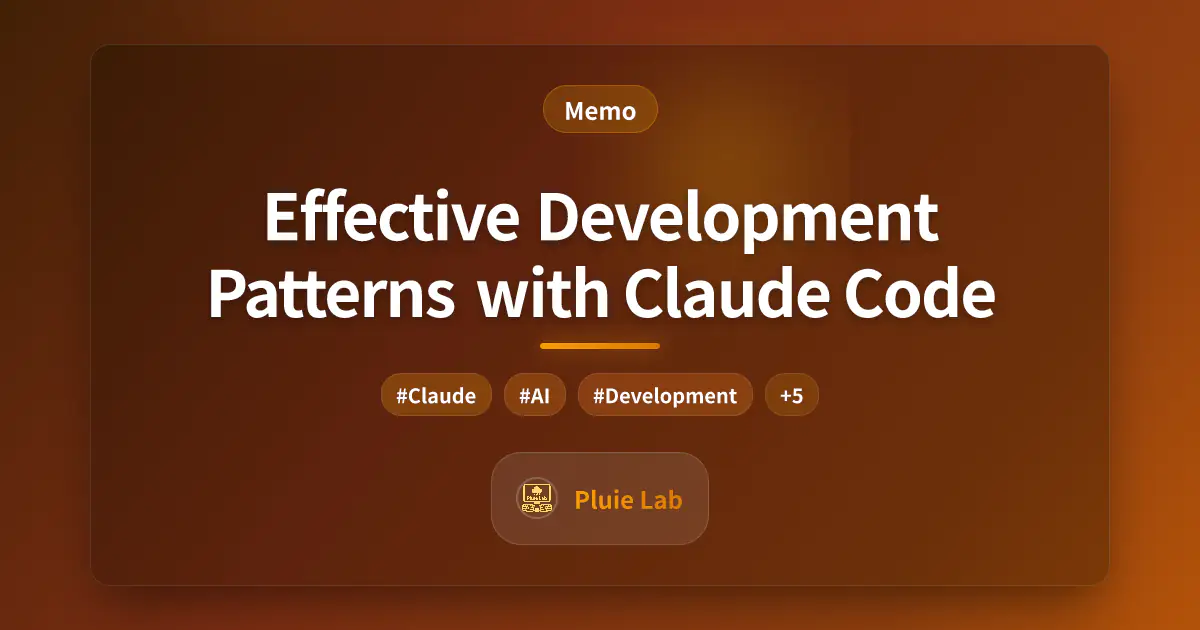Effective Development Patterns with Claude Code
Note: This article is based on the author's personal experiences and opinions. These practices have been effective in specific projects and situations, but may not be optimal for all development environments.
In today's world where AI-assisted development is becoming commonplace, Claude Code stands out as a powerful tool that enables direct collaboration with AI through your terminal. However, to maximize the benefits of this tool, it helps to understand certain patterns and practices.
In this article, I'll share best practices and insights from my personal experience working with Claude Code.
Efficient Directory Structure
When collaborating with AI, having an easily understandable codebase structure is crucial. The following pattern has proven effective:
src/
└── services/ # Functional code units
└── auth.ts # Authentication functionality
└── api.ts # API communication functionality
└── utils/ # General-purpose functions
└── format.ts # Formatting functions
└── date.ts # Date manipulation functions
Organize Files by Functionality
Claude Code can better understand and make appropriate suggestions or modifications to code that is organized by functionality:
-
service = one functionality: Dividing files by functions such as authentication, API communication, and data processing helps Claude Code focus on understanding specific functionalities.
-
utils = helper functions: Grouping reusable functions in a
utilsdirectory makes it easier for Claude Code to find appropriate functions.
However, dividing your code too finely can make it difficult for AI to understand complex dependencies, reducing the likelihood of generating the expected code. Aim for moderate granularity.
Test-Driven Development Approach
Tests are extremely important in collaborative development with AI. Writing tests:
- Allows objective evaluation of AI-generated code quality
- Clearly defines specifications, enabling AI to generate more accurate code
- Reduces developer burden, allowing focus on code review
Claude Code can understand logic from test code and propose implementations. Communicating with a test-first approach helps clearly convey expected behavior.
Effective Use of CLAUDE.md
The CLAUDE.md file is an important tool for communicating project context to AI. Here's how to use it effectively:
Regular Updates
Update your CLAUDE.md as your project progresses. For example:
# Project Overview
...
# TODO
- [x] Login functionality
- [ ] Logout functionality
- [ ] Password reset functionality
Including a TODO list helps AI understand the current development status and generate code that considers upcoming tasks.
Detailed Specification Documentation
Documenting design decisions and technical constraints increases the probability of AI generating appropriate code:
# Database Access
- Using SQLite
- Models defined with Drizzle ORM
- Always use transactions
Setting Realistic Expectations
Claude Code is very powerful, but not perfect. The most effective approach in actual development is:
-
Be mindful of the 80% rule: AI often generates code at about 80% quality. Plan to have humans adjust the remaining 20%.
-
Big picture over detailed instructions: Rather than instructing on small modifications one by one, explaining the overall picture and letting AI think often leads to better results.
-
Caution with partial modifications: Instructions like "just fix this part" can sometimes cause unintended changes elsewhere. Always be aware of the overall context.
Efficient Use of Git
Effective use of git is important when collaborating with Claude Code:
Commit Frequently
AI often changes many files at once, so making frequent commits:
- Makes it easier to track changes
- Allows easy rollback if changes don't meet expectations
- Records incremental evolution
Leverage Branch Strategies
The workflow of creating branches for features and merging them when complete is also effective for collaboration with AI.
Microservice Mindset
When codebases grow too large, it becomes difficult for AI to grasp the context:
-
Make components independent: Design loosely coupled components where possible to limit what AI needs to understand at once.
-
Clear interfaces: Clearly defining interfaces between components makes it easier for AI to generate code that adheres to those interfaces.
-
Use /clear effectively: When conversations get too long, unintended modifications may occur due to previous context. Clearing conversations by functionality can be a useful strategy.
File-Based Instructions
For complex instructions or code examples, communicating through files is more effective than direct input in the terminal:
# Write instructions in claude-question.md and pass to Claude Code
npm run claude @claude-question.md
This approach:
- Allows use of editor completion features when creating instructions
- Maintains a history of instructions for later reuse
- Makes it easy to convey lengthy text or complex code examples
Installing Claude Code Per Project
While Claude Code can be installed globally, it's recommended to install it as a development dependency for each project:
npm install --save-dev @anthropic-ai/claude-code
Installing it as a development dependency in your package.json offers several benefits:
- Maintains compatibility with project-specific Node.js versions and environment configurations
- Ensures consistent Claude Code versions across your team
- Allows the same version to be used in CI/CD pipelines
Adding a script to your project's package.json is convenient:
"scripts": {
"claude": "claude"
}
Conclusion
Claude Code is a powerful development tool, but using it appropriately is key to maximizing its capabilities. By implementing practices such as thoughtful directory structure, test-driven development, leveraging CLAUDE.md, setting realistic expectations, efficient git usage, microservice thinking, and file-based instructions, you can greatly enhance your collaborative development experience with AI.
Rather than viewing AI as an assistant that writes perfect code, consider it a partner that quickly builds 80% of the foundation, leaving you to finish the rest. This mindset allows for more stress-free and efficient development.
